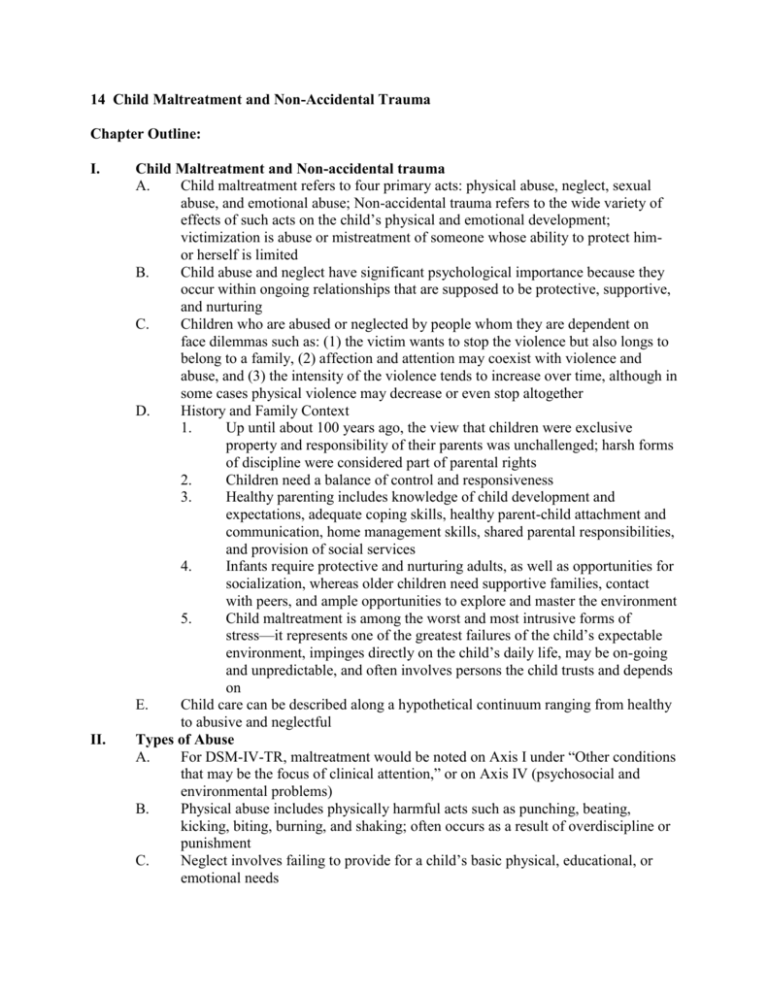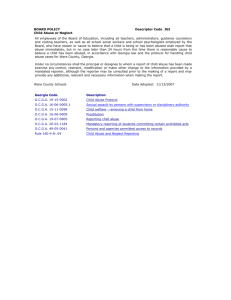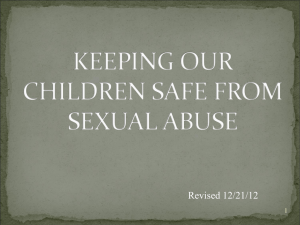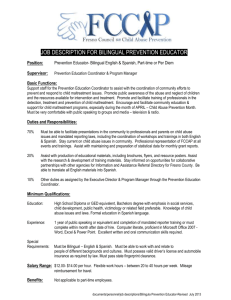
14 Child Maltreatment and Non-Accidental Trauma
Chapter Outline:
I.
II.
Child Maltreatment and Non-accidental trauma
A.
Child maltreatment refers to four primary acts: physical abuse, neglect, sexual
abuse, and emotional abuse; Non-accidental trauma refers to the wide variety of
effects of such acts on the child’s physical and emotional development;
victimization is abuse or mistreatment of someone whose ability to protect himor herself is limited
B.
Child abuse and neglect have significant psychological importance because they
occur within ongoing relationships that are supposed to be protective, supportive,
and nurturing
C.
Children who are abused or neglected by people whom they are dependent on
face dilemmas such as: (1) the victim wants to stop the violence but also longs to
belong to a family, (2) affection and attention may coexist with violence and
abuse, and (3) the intensity of the violence tends to increase over time, although in
some cases physical violence may decrease or even stop altogether
D.
History and Family Context
1.
Up until about 100 years ago, the view that children were exclusive
property and responsibility of their parents was unchallenged; harsh forms
of discipline were considered part of parental rights
2.
Children need a balance of control and responsiveness
3.
Healthy parenting includes knowledge of child development and
expectations, adequate coping skills, healthy parent-child attachment and
communication, home management skills, shared parental responsibilities,
and provision of social services
4.
Infants require protective and nurturing adults, as well as opportunities for
socialization, whereas older children need supportive families, contact
with peers, and ample opportunities to explore and master the environment
5.
Child maltreatment is among the worst and most intrusive forms of
stress—it represents one of the greatest failures of the child’s expectable
environment, impinges directly on the child’s daily life, may be on-going
and unpredictable, and often involves persons the child trusts and depends
on
E.
Child care can be described along a hypothetical continuum ranging from healthy
to abusive and neglectful
Types of Abuse
A.
For DSM-IV-TR, maltreatment would be noted on Axis I under “Other conditions
that may be the focus of clinical attention,” or on Axis IV (psychosocial and
environmental problems)
B.
Physical abuse includes physically harmful acts such as punching, beating,
kicking, biting, burning, and shaking; often occurs as a result of overdiscipline or
punishment
C.
Neglect involves failing to provide for a child’s basic physical, educational, or
emotional needs
D.
III.
IV.
Sexual abuse includes sexual touching, intercourse, incest, rape, sodomy,
exhibitionism, and commercial exploitation through prostitution or the production
of pornography
E.
Emotional abuse includes acts or omissions that have caused, or could cause,
serious behavioral, cognitive, emotional, or mental disorders; emotional abuse
exists, to some degree, in all forms of maltreatment
F.
Exploitation includes child labour and child prostitution
Prevalence and Context
A.
Incidence of Abuse and Neglect in North America
1.
Close to 3 million suspected cases of child abuse and neglect each year,
about 1 million confirmed
2.
Child neglect accounts for close to 60% of all documented maltreatment in
the U.S.; about 20% of cases involve physical abuse and 10% involve
sexual abuse; 25% of cases involve more than one type of maltreatment
3.
Lifetime prevalence estimates (based on retrospective accounts) for
physical abuse are 31.2% of males and 21.1% of females, and for sexual
abuse are 4.3% of males and 12.8% of females
B.
Characteristics of Victimized Children
1.
Children’s sex and age are related to risk of maltreatment
a.
Younger children are at greater risk for physical neglect
b.
Toddlers, preschoolers, and young adolescents are more at risk for
physical and emotional abuse
c.
Sexual abuse incidence is relatively constant from age 3 on
d.
80% of sexual abuse victims are female
e.
Boys are more likely to be sexually abused by male non-family
members, whereas girls by male family members
f.
Racial and ethnic background is not related to risk for
maltreatment
C.
Characteristics of Family and Perpetrator
1.
More common among the poor and disadvantaged
2.
Children from single-parent (especially father-only) homes and large
families more at risk
3.
Child’s parent is the perpetrator in 85% of cases, except for sexual abuse,
where 50% of cases involve non-parent figures; the mother is the
perpetrator of neglect 90% of the time
4.
Males are the offenders in the majority of sexual abuse (90%), about half
being the child’s father-figure
5.
The most common perpetrator overall is a female parent alone, usually
under 30 years of age
D.
Cross-Cultural Comparisons
1.
Physical and sexual abuse are found in all societies
2.
It is estimated that 40 million children under the age of 15 are victims of
maltreatment annually worldwide
Developmental Course and Psychopathology
A.
Resilience and Adaptation
1.
B.
Maltreatment does not affect each child in a predictable or consistent way,
and can result in developmental failure and limited adaptation
2.
Protective factors include positive self-esteem and sense of self, and
having a positive relationship with at least one important and consistent
person who provides support and protection
Developmental Consequences
1.
Early attachment and emotion regulation
a.
Many maltreated children show an insecure-disorganized
attachment pattern, characterized by a mixture of approach and
avoidance, helplessness, apprehension, and a general disorientation
b.
Maltreated children have difficulty understanding, labeling, and
regulating internal emotional states
c.
Tendency to inhibit emotional expression and regulation,
remaining fearful and on alert; show increased attention to angerand threat-related signals
d.
Inability to regulate emotions is associated with both internalizing
disorders and externalizing disorders
2.
Brain Development
a.
Children and adults with a history of child abuse show long-term
alterations in the hypothalamic-pituitary-adrenal (HPA) axis and
norepinephrine systems, which have a significant affect on
responsiveness to stress
b.
Acute and chronic forms of stress associated with maltreatment
may cause changes in brain development and structureparticularly neuroendocrine system
3.
Emerging views of self and others
a.
Maltreated children may develop negative representational models
of self and others
b.
Often feelings of inferiority, powerlessness and betrayal, which
become part of their self-identity
c.
Children may shift blame to themselves or situational factors
d.
Maltreated girls tend to show more internalizing signs of distress
such as shame and self-blame, while maltreated boys show
heightened levels of verbal and physical aggression
4.
Emotional and Behavioral Problems
a.
Maltreated children may be more distracted by aggressive stimuli
and make hostile attributions for the actions of others
b.
Physically abused and neglected children show less skill at
recognizing or responding to distress in others, and may respond to
others’ distress with fear, physical attack, or anger
c.
Maltreated children, especially physically abused children, are
more physically and verbally aggressive toward their peers, and are
more likely to be less popular and socially rejected
d.
Maltreated children, especially neglected children, often withdraw
and avoid peer interactions
e.
C.
V.
Neglected children have the most severe and wide-ranging
problems in school and interpersonal adjustment
f.
Sexually abused children are described as more anxious,
inattentive, and unpopular, and as having less autonomy and selfguidance in completing school work
Psychopathology and Adult Outcomes
1.
Individuals with histories of physical abuse are at increased risk to
develop interpersonal problems involving aggression and violence
(“cycle-of-violence”)
2.
Symptoms of depression, emotional distress and suicidal ideation are
common features of children with histories of physical, emotional, and
sexual abuse
3.
Teens with a history of maltreatment are at much greater risk of substance
abuse
4.
20-50% of children and adolescents with histories of maltreatment
involving sexual abuse or combined sexual and physical abuse meet
criteria for post-traumatic stress disorder (PTSD), and about a third of
childhood victims for sexual abuse, physical abuse, or neglect meet
criteria for lifetime PSTD
5.
Sexual abuse can lead to traumatic sexualization- when a child’s sexual
knowledge and behavior are shaped in developmentally inappropriate
ways
6.
Sexual abuse may also lead to weight problems, eating disorders, poor
physical health care, physically destructive behavior, and in early
adulthood promiscuity, prostitution, sexual aggression, and victimization
of others
7.
Most abused children do not go on to commit crimes, although there is a
significant connection between maltreatment and subsequent arrests and
sexual and physical violence; a history of maltreatment is associated with
an earlier mean age at first offense, a higher frequency of offenses, and a
greater chronicity of offending
Causes
A.
Physical Abuse and Neglect
1.
Many abusive and neglectful parents have had little exposure to positive
parental models and supports
2.
Often associated with a greater degree of family stress
3.
Information-processing disturbances may cause maltreating parents to
misperceive or mislabel their child’s behavior in ways that lead to
inappropriate responses
4.
Maltreating parents often lack awareness or understanding of
developmentally appropriate expectations
5.
Neglectful parents have more striking personality disorders, inadequate
knowledge of child needs, and chronic social isolation than abusive
parents; neglectful care-givers typically disengage when under stress,
whereas abusive parents become emotionally and behaviorally reactive
6.
B.
C.
With abuse, may see a conditioning of negative arousal and emotions with
certain events that can later trigger the same negative feelings
7.
No child characteristic, such as conduct problems or handicapping
conditions, has been associated with the risk of maltreatment, once
environmental and adult factors are controlled for (with the exception of
girls being sexually abused more often than boys)
8.
Family conflict and marital violence have a causal connection to child
maltreatment
9.
In a dynamic process that includes both destabilizing factors and
compensatory factors, both parental and situational factors interact to
either increase or decrease the risk of physical abuse or neglect
Sexual Abuse
1.
Most offenders are males and most meet the DSM-IV-TR criteria for
pedophilia
2.
Offenders seldom resort to violence or force to gain the child’s
compliance; they are attentive to child’s needs in order to gain affection,
interest and loyalty, then gradually indoctrinate the child into sexual
activity
3.
Often a perpetrator has special status such as a teacher, religious figure, or
scout leader, and intentions may be covered by giving the child a sense of
entitlement and privilege
4.
Offenders often have their own histories of abuse
5.
Incestuous families can often be characterized by factors that tend to
protect the “family secret” and maintain control and domination by the
abuser, such as greater social isolation, restrictive personal autonomy, and
deference to strict morality and religiosity
6.
Certain situational factors increase children’s vulnerability to being
sexually abused, which offenders exploit to their advantage, including
having family problems, being unsupervised and spending a lot of time
alone, and being unsure of themselves; prefer victims that are attractive,
young, and trusting
Social and Cultural Dimensions
1.
Our society condones and glorifies violence
2.
Media and entertainment stereotypically portray females as powerless and
passive and males as powerful, with women deferring to the powerful men
and men challenging assertive women
3.
Racism and inequality are major sociocultural factors contributing to
abuse and neglect of children and adults of minority groups
4.
Poverty is associated with severe restrictions in the child’s expectable
environment; adults below the poverty level suffer more individual and
family problems such as substance abuse, which is involved in 40% of
child maltreatment cases
5.
Social and cultural disadvantage may result in an extra burden of stress
and confusion, and limited alternatives—the coping abilities of family
members are impaired by circumstances and further constrained by their
resources; maltreating families often lack significant social connections
6.
VI.
Child maltreatment occurs to a certain extent because of limited cultural
opportunities to learn about appropriate child-rearing and to receive
necessary education and supports, as well as long-held social customs that
endorse the use of physical force to resolve child conflicts
7.
The erotic portrayal of children in pornography and mainstream
advertising may blur boundaries and send inappropriate messages
Prevention and Treatment
A.
Many children and adults seeking treatment relating to maltreatment are under
some form of legal constraint, and are not likely to seek help
B.
Physical Abuse and Neglect
1.
Efforts to enhance positive experiences early in the development of the
parent-child relationship hold promise for preventing maltreatment
2.
Treatment often begins by increasing positive parent-child interactions
3.
Cognitive-behavioral approaches are the most widely-supported methodsinclude relaxation and self-management skills training, stress and anger
management skills training, cognitive restructuring and problem-solving
training, in combination with structured training in child-rearing skills
4.
Treatment for neglect focuses on parenting skills and expectations,
coupled with training in social competence and the management of
everyday demands such as financial planning and home cleanliness
5.
Resilient-peer treatment (pairing the maltreated child with resilient peers
during play activities) may help withdrawn children develop peer
relationship skills
C.
Sexual Abuse
1.
Children’s treatment programs are only beginning and are difficult to
devise because sexual abuse affects each child differently
2.
Treatment programs usually attempt to restore children’s sense of trust,
safety, and guiltlessness, through education and support, cognitivebehavioral methods, and group therapy; parents of sexually abused
children also benefit from treatment
3.
Sexually abused children need to express feelings about the abuse, and
may need specialized treatment if they are suffering from PTSD








